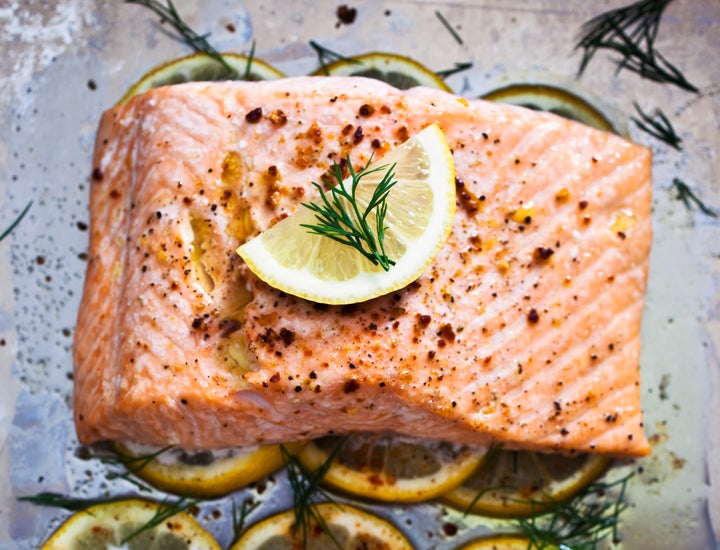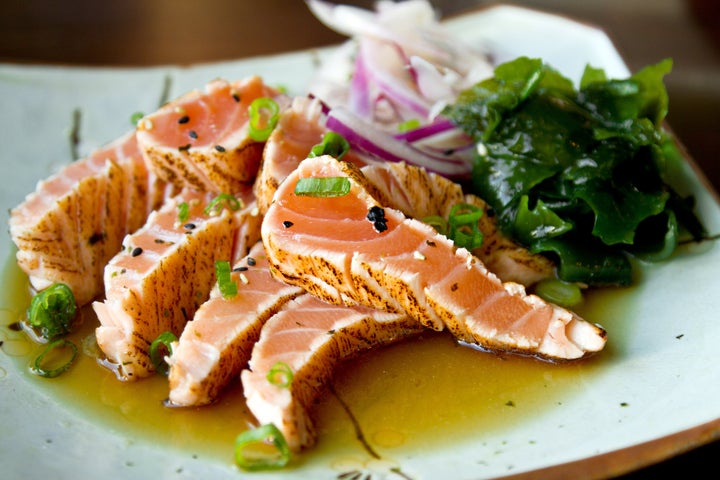When it comes to fish, chef Santiago Gomez of the forthcoming Palo Santo in Atlanta said salmon is his favorite. It’s rich in flavor and simple to prepare ― but easy to mess up if one overcooks it.
Have no fear, though. With the help of experts, we have the tips you need to prepare a delicious salmon fillet in a minimal amount of time.
Choose your salmon
Shopping from a specialty fishmonger is great, but not always practical. When you can, try chatting with your fish person to suss out what kind of salmon you’re purchasing: Fresh or farmed?
“That conversation can only exist from the end of March to September, because that’s the season,” said Joe Gurrera of seafood market Citarella in New York. “If you see somebody having wild salmon in November — it’s either not, or it’s frozen and defrosted.”
There’s nothing wrong with farmed salmon, though it may contain added antibiotics. Ultimately, both fresh and farmed are nutritious protein choices.
And for one particular method below, you’ll need access to sushi-grade salmon. It’s important to plan ahead for your preparation method when you’re shopping.
Here are three simple, no-fail ways to prepare salmon.
1. Pan-seared

You can’t go wrong with pan-searing your salmon. Well, you can, but not if you heed Gomez’s advice.
“I really love it pan-seared so you can get a nice crispy skin, because I believe the skin of the salmon really has a lot of flavor,” Gomez said.
First, pat your salmon’s skin and flesh with a paper towel to make sure it’s really dry. Then, season it with salt and pepper.
Put the salmon on a pan (nonstick, ideally) with just a little bit of olive oil (don’t pre-heat it!), skin side down.
“The idea is to get a really brown, golden skin so it’s really crispy,” Gomez said. “We don’t want to burn it, so we turn the heat up really, really slow until you flip it. You can feel with your finger, that it’s crispy, that it’s really crunchy.”
After you flip the salmon, raise the temperature to get a crust on the other side. You’re looking at a total cooking time of six to eight minutes, depending on the thickness of your salmon, which will give you a medium-rare temperature. (If you’re not certain it’s ready, use an instant-read thermometer and make sure the salmon is at least 120 degrees Fahrenheit for medium-rare.)
When Gomez takes the salmon off the pan, he likes to rest it on a paper towel for a couple of minutes to absorb the extra oil.
One key to serving salmon, he said, is the type of sauce you use (but it doesn’t need much!).
“Citrus sauces work really good. So it can be more like mandarin or yuzu, or it can be lime or grapefruit. Any citrus is going to give you a really, really nice sauce for the salmon. It breaks out the fattiness of the fish,” Gomez said. “You don’t want it plain, but you really don’t need too much sauce on the salmon to really have the flavor. But I believe if you put something acidic or sweet, it will give you a nice balance in your dish.”
2. The toaster oven method

If you have a toaster oven, you can use it to make salmon (and it’s Gurrera’s favorite method). This is especially great if you buy a small, single-serving piece of salmon and you don’t want to crank up your oven.
Preheat the toaster oven to 375 degrees. Meanwhile, Gurrera places his salmon in a stainless steel bowl and adds olive oil, salt and pepper.
“Salmon happens to be a very flavorful fish. So you don’t need much more than that,” he said.
Combine all the ingredients in the bowl and then place the salmon on a little pan for the toaster oven. One benefit of cooking it in the toaster oven is that you don’t have to hover over the salmon to flip it. You only want to cook it for about seven to eight minutes to avoid overcooking, Gurrera said. (And again, if you’re not confident that it’s done, you can use an instant-read thermometer.)
After cooking, Gurrera doesn’t let the salmon rest — it goes immediately onto a plate and is served simply with a vegetable.
Sauce? Not for Gurrera. “Of course lemon juice is fine. But I want to taste the flavor of the fish. I want to taste what I’m eating,” he said.
3. Tataki-style

Tataki is a Japanese method of cooking thinly sliced protein quickly. It’s one of Gomez’s preferred methods for salmon. For this method, it has to be sushi-grade salmon, since it will be practically raw when you’re done cooking it. (If you’re concerned about the food safety of eating nearly raw fish, read this guide and you’ll understand why this method requires sushi-grade salmon.)
Start by removing the salmon’s skin (or better yet, ask your fishmonger to remove it for you) and then season it with salt and pepper. Get a sauté pan really hot on high heat. “It has to be to the point that you’re seeing smoke,” Gomez said.
Sear the salmon for one minute on each side and then place it into a bowl to cool it. Slice it thinly and serve with soy sauce, lime juice and sesame oil. “It gives you more flavor because you have the crust, but it’s raw on the inside,” Gomez said.
If you want an easy, zesty sauce recipe, Gomez suggests blending garlic, cilantro, rice vinegar, salt and lime juice. It forms a saucy paste in the blender that goes well with pan-seared or tataki-style salmon. Add jalapeños for extra spice — and enjoy the vibrant green hue of the sauce.